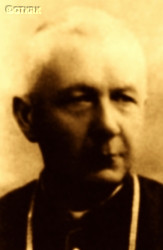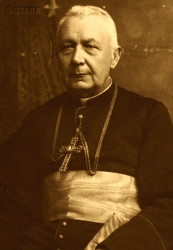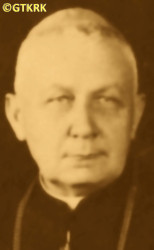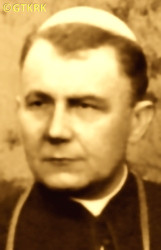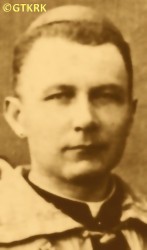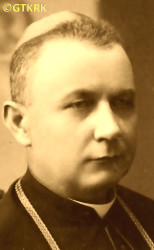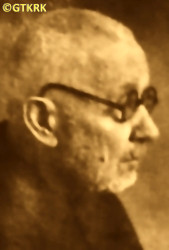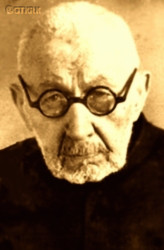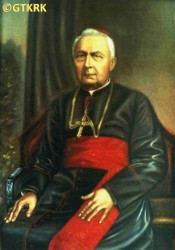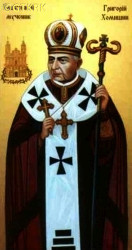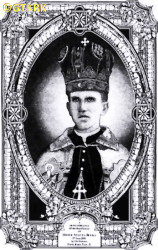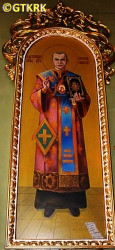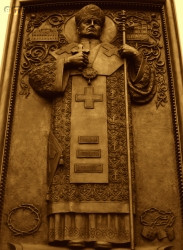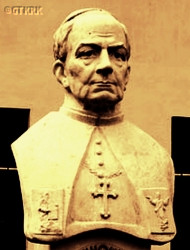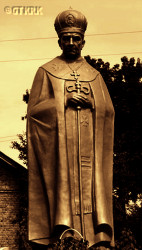Roman Catholic
St Sigismund parish
05-507 Słomczyn
85 Wiślana Str.
Konstancin deanery
Warsaw archdiocese, Poland
full list:
displayClick to display full list

searchClick to search full list by categories
wyświetlKliknij by wyświetlić pełną listę po polsku

szukajKliknij by przeszukać listę wg kategorii po polsku

Martyrology of the clergy — Poland
XX century (1914 – 1989)
personal data
religious status
blessed
surname
CHOMYSZYN
forename(s)
Gregory (pl. Grzegorz)
beatification date
27.06.2001more on
www.swzygmunt.knc.pl
[access: 2013.05.19]

the RC Pope John Paul IImore on
en.wikipedia.org
[access: 2014.09.21]
function
bishop
creed
Ukrainian Greek Catholic GCmore on
en.wikipedia.org
[access: 2013.05.19]
diocese / province
Stanyslaviv GC eparchymore on
en.wikipedia.org
[access: 2013.05.19]
academic distinctions
Doctor of Theology
nationality
Ukrainian
date and place
of death
28.12.1945

Kievtoday: Kiev city rai., Kiev city obl., Ukraine
more on
en.wikipedia.org
[access: 2023.03.02]
details of death
After German and Russian invasion of Poland in 09.1939 and start of the World War II, after start of Russian occupation, for the first time arrested by the Russians in 1939.
Released.
Arrested again by the Russian genocidal NKVD police on 15.04.1945, right at the end of the World War II, after German expulsion by the victorious Russians and start of another Russian occupation.
Beaten up in his bedroom and thrown down the staircase.
After few days in Lviv prison taken to Lukyuaniwska prison in Kiev.
Interrogated many times, tortured — from 21.04 till 09.05.1945 interrogated 11 times, the longest for 11 hours; last time on 11.09.1945.
Accused of „anti–Russian activities”, collaboration with „Polish fascists”, „collaboration with Germans”, „collaboration with nationalist Ukrainian UPA organisation”… On 21.12.1945 taken to prison hospital where few days later perished.
cause of death
murder
perpetrators
Russians
sites and events
Kiev (Lyukyanivska)Click to display the description, Lviv (Brygidki)Click to display the description, Ribbentrop‐MolotovClick to display the description, Pius XI's encyclicalsClick to display the description
date and place
of birth
25.03.1867

Hadynkivtsitoday: Kopychyntsi hrom., Chortkiv rai., Ternopil obl., Ukraine
more on
en.wikipedia.org
[access: 2022.08.05]
parents
CHOMYSZYN Luke
🞲 ?, ? — 🕆 ?, ?

FORMANIUK Victoria
🞲 ?, ? — 🕆 ?, ?
presbyter (holy orders)
ordination
18.11.1893

Stanislavivtoday: Ivano‐Frankivsk, Stanislaviv/Ivano‐Frankivsk rai., Stanislaviv/Ivano‐Frankivsk obl., Ukraine
more on
en.wikipedia.org
[access: 2020.11.20]
Resurrection of Christ GC cathedral churchmore on
en.wikipedia.org
[access: 2019.12.26]
positions held
1904 – 1945
bishop — Stanislaviv GK eparchy — appointment: on 06.05.1904; ordination: on 19.06.1904, Our Lord's Resurrection cathedral in Stanislaviv
1902 – 1904
rector — Lvivtoday: Lviv urban hrom., Lviv rai., Lviv obl., Ukraine
more on
en.wikipedia.org
[access: 2022.01.16] ⋄ Greek Catholic Theological Seminary
1901 – 1902
vicar — Kolomyiatoday: Kolomyia rai., Stanislaviv/Ivano‐Frankivsk obl., Ukraine
more on
pl.wikipedia.org
[access: 2020.07.31] ⋄ St Michael the Archangel GC parish ⋄ Kolomyiatoday: Kolomyia rai., Stanislaviv/Ivano‐Frankivsk obl., Ukraine
more on
pl.wikipedia.org
[access: 2020.07.31] GC deanery — also: prefect of secondary schools
1899 – 1901
vicar — Stanislavivtoday: Ivano‐Frankivsk, Stanislaviv/Ivano‐Frankivsk rai., Stanislaviv/Ivano‐Frankivsk obl., Ukraine
more on
en.wikipedia.org
[access: 2020.11.20] ⋄ Our Lord's Resurrection GC cathedral church — also: prefect of secondary schools
1894 – 1899
PhD student — Viennatoday: Vienna state, Austria
more on
en.wikipedia.org
[access: 2020.07.31] ⋄ theology, St Augustine Higher Scientific Institute for Diocesan Priests („Augustineum/Frintaneum”) — PhD thesis Lat. „De epiclesi” (Eng. „Epiclesis”) (obrona 07.12.1931), public defense on 22.02.1899
1894 – 1899
vicar — Viennatoday: Vienna state, Austria
more on
en.wikipedia.org
[access: 2020.07.31] ⋄ St Barbara GC parish
1893 – 1894
vicar — Stanislavivtoday: Ivano‐Frankivsk, Stanislaviv/Ivano‐Frankivsk rai., Stanislaviv/Ivano‐Frankivsk obl., Ukraine
more on
en.wikipedia.org
[access: 2020.11.20] ⋄ Our Lord's Resurrection GC cathedral church
1888 – 1893
student — Lvivtoday: Lviv urban hrom., Lviv rai., Lviv obl., Ukraine
more on
en.wikipedia.org
[access: 2022.01.16] ⋄ philosophy and theology, John Casimir University [i.e. clandestine John Casimir University (1941‐1944) / Ivan Franko University (1940‐1941) / John Casimir University (1919‐1939) / Franciscan University (1817‐1918)]
1888 – 1893
student — Lvivtoday: Lviv urban hrom., Lviv rai., Lviv obl., Ukraine
more on
en.wikipedia.org
[access: 2022.01.16] ⋄ philosophy and theology, Greek Catholic Theological Seminary
others related
in death
BAŁAHURAKClick to display biography Vladimir (Bp Gregory), ŁUKACZClick to display biography Simon
sites and events
descriptions
Kiev (Lyukyanivska): Russian political prison in Kiev, in the first half of 20th century run by the genocidal NKVD, informally referred to as prison No 1, formally as Investigative Prison No 13 (SIZO#13). It was founded in the early 19th century. In the 20th century, during the Soviet times, the prison church was transformed into another block of cells. During the reign of J. Stalin in Russia, more than 25,000 prisoners passed through it. (more on: en.wikipedia.orgClick to attempt to display webpage
[access: 2014.09.21])
Lviv (Brygidki): Penal prison, then at 34 Kazimierzowska Str. in Lviv — in the buildings of the former monastery of the Order of St Brigid, in 1784 — after the first partition of Poland and after the dissolution of the religious orders as part of the so—called Josephine dissolutions — converted by the partitioning Austrian authorities into a prison. In 1939‐1941, the Russians held there thousands of prisoners, most of them Poles. On c. 26.06.1941, in the face of the German invasion and attack of their erstwhile ally, the Russians, during a panic escape (the left Lviv exactly on 26.06.1941), genocideally murdered several thousand prisoners. In 1941‐1944 the prison was run by the Germans and mass murders of Polish, Jewish and Ukrainian civilians took place there. After start of another Russian occupation in 1941 prison in which the executions were carried out on prisoners sentenced to death. (more on: en.wikipedia.orgClick to attempt to display webpage
[access: 2014.09.21])
Ribbentrop‐Molotov: Genocidal Russian‐German alliance pact between Russian leader Joseph Stalin and German leader Adolf Hitler signed on 23.08.1939 in Moscow by respective foreign ministers, Mr. Vyacheslav Molotov for Russia and Joachim von Ribbentrop for Germany. The pact sanctioned and was the direct cause of joint Russian and German invasion of Poland and the outbreak of the World War II in 09.1939. In a political sense, the pact was an attempt to restore the status quo ante before 1914, with one exception, namely the „commercial” exchange of the so‐called „Kingdom of Poland”, which in 1914 was part of the Russian Empire, fore Eastern Galicia (today's western Ukraine), in 1914 belonging to the Austro‐Hungarian Empire. Galicia, including Lviv, was to be taken over by the Russians, the „Kingdom of Poland” — under the name of the General Governorate — Germany. The resultant „war was one of the greatest calamities and dramas of humanity in history, for two atheistic and anti‐Christian ideologies — national and international socialism — rejected God and His fifth Decalogue commandment: Thou shall not kill!” (Abp Stanislav Gądecki, 01.09.2019). The decisions taken — backed up by the betrayal of the formal allies of Poland, France and Germany, which on 12.09.1939, at a joint conference in Abbeville, decided not to provide aid to attacked Poland and not to take military action against Germany (a clear breach of treaty obligations with Poland) — were on 28.09.1939 slightly altered and made more precise when a treaty on „German‐Russian boundaries and friendship” was agreed by the same murderous signatories. One of its findings was establishment of spheres of influence in Central and Eastern Europe and in consequence IV partition of Poland. In one of its secret annexes agreed, that: „the Signatories will not tolerate on its respective territories any Polish propaganda that affects the territory of the other Side. On their respective territories they will suppress all such propaganda and inform each other of the measures taken to accomplish it”. The agreements resulted in a series of meeting between two genocidal organization representing both sides — German Gestapo and Russian NKVD when coordination of efforts to exterminate Polish intelligentsia and Polish leading classes (in Germany called «Intelligenzaktion», in Russia took the form of Katyń massacres) where discussed. Resulted in deaths of hundreds of thousands of Polish intelligentsia, including thousands of priests presented here, and tens of millions of ordinary people,. The results of this Russian‐German pact lasted till 1989 and are still in evidence even today. (more on: en.wikipedia.orgClick to attempt to display webpage
[access: 2015.09.30])
Pius XI's encyclicals: Facing the creation of two totalitarian systems in Europe, which seemed to compete with each other, though there were more similarities than contradictions between them, Pope Pius XI issued in 03.1937 (within 5 days) two encyclicals. In the „Mit brennender Sorge” (Eng. „With Burning Concern”) published on 14.03.1938, condemned the national socialism prevailing in Germany. The Pope wrote: „Whoever, following the old Germanic‐pre‐Christian beliefs, puts various impersonal fate in the place of a personal God, denies the wisdom of God and Providence […], whoever exalts earthly values: race or nation, or state, or state system, representatives of state power or other fundamental values of human society, […] and makes them the highest standard of all values, including religious ones, and idolizes them, this one […] is far from true faith in God and from a worldview corresponding to such faith”. On 19.03.1937, published „Divini Redemptoris” (Eng. „Divine Redeemer”), in which criticized Russian communism, dialectical materialism and the class struggle theory. The Pope wrote: „Communism deprives man of freedom, and therefore the spiritual basis of all life norms. It deprives the human person of all his dignity and any moral support with which he could resist the onslaught of blind passions […] This is the new gospel that Bolshevik and godless communism preaches as a message of salvation and redemption of humanity”… Pius XI demanded that the established human law be subjected to the natural law of God , recommended the implementation of the ideal of a Christian state and society, and called on Catholics to resist. Two years later, National Socialist Germany and Communist Russia came together and started World War II. (more on: www.vatican.vaClick to attempt to display webpage
[access: 2023.05.28], www.vatican.vaClick to attempt to display webpage
[access: 2023.05.28])
sources
personal:
www.swzygmunt.knc.plClick to attempt to display webpage
[access: 2013.05.19], pl.wikipedia.orgClick to attempt to display webpage
[access: 2013.05.19]
original images:
www.istpravda.com.uaClick to attempt to display webpage
[access: 2015.03.01], commons.wikimedia.orgClick to attempt to display webpage
[access: 2015.03.01], audiovis.nac.gov.plClick to attempt to display webpage
[access: 2019.12.26], uk.wikipedia.orgClick to attempt to display webpage
[access: 2019.12.26], audiovis.nac.gov.plClick to attempt to display webpage
[access: 2019.12.26], commons.wikimedia.orgClick to attempt to display webpage
[access: 2019.12.26], www.radiomaryja.plClick to attempt to display webpage
[access: 2019.12.26], homyshyn.te.uaClick to attempt to display webpage
[access: 2015.03.01], ugcc.if.uaClick to attempt to display webpage
[access: 2019.12.26], ugcc.if.uaClick to attempt to display webpage
[access: 2019.12.26], www.catholic.orgClick to attempt to display webpage
[access: 2019.12.26], risu.org.uaClick to attempt to display webpage
[access: 2019.12.26], blazejowskyj.comClick to attempt to display webpage
[access: 2019.12.26], commons.wikimedia.orgClick to attempt to display webpage
[access: 2015.03.01], homyshyn.te.uaClick to attempt to display webpage
[access: 2015.03.01], homyshyn.te.uaClick to attempt to display webpage
[access: 2014.09.21]
LETTER to CUSTODIAN/ADMINISTRATOR
If you have an Email client on your communicator/computer — such as Mozilla Thunderbird, Windows Mail or Microsoft Outlook, described at WikipediaPatrz:
en.wikipedia.org, among others — try the link below, please:
LETTER to CUSTODIAN/ADMINISTRATORClick and try to call your own Email client
If however you do not run such a client or the above link is not active please send an email to the Custodian/Administrator using your account — in your customary email/correspondence engine — at the following address:

giving the following as the subject:
MARTYROLOGY: CHOMYSZYN Gregory
To return to the biography press below:
 Click to return to biography
Click to return to biography








